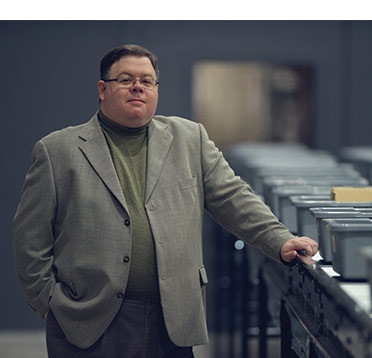Refresh for the Right Reason: To Future-Proof Your Infrastructure
With its storage systems reaching end of life, Atlantic Packaging changes its approach to IT upgrades and makes an investment in its future.

- by Calvin Hennick
- Freelance Journalist |
“We’re looking for solutions that don’t require someone to be constantly messing with them,” Atlantic Packaging IT Manager Robbie Walker says. Photography by Peter Artemenko
—
As an independent business in the competitive industry of industrial packaging, North Carolina-based Atlantic Packaging has historically taken a frugal approach to solving problems.
"We are always looking for the most effective way to solve our challenges — whether they're sales challenges, operational challenges or IT challenges — as inexpensively as possible," says IT Manager Robbie Walker. As a result, the company has typically found itself near the end of the IT adoption curve. For example, Walker says, the company didn't implement virtualization in its data center until well after many other organizations adopted the technology.
At times, Walker says, this approach to infrastructure upgrades has served the company well, letting its IT staff learn from other companies' mistakes. But more often, the reluctance to upgrade resources in a timely fashion — coupled with a tendency to implement the least expensive solution when the time came for a refresh — has backfired.
The problem, Walker says, is that the company too often treated IT purchases in the past as transactions to solve an immediate problem for the lowest possible price, rather than as investments to create lasting business value. What's more, some of these inexpensive transactions had a way of evolving into costly, long-term investments.
For example, Atlantic Packaging has an office in the Dominican Republic, and the company initially took a transactional approach to managing the island location's infrastructure. As a result, Walker spent nearly an entire holiday season there one year, solving IT problems. While the initial price of the infrastructure investments the company made were lower than other options, the long-term costs included extensive travel, untold hours of labor and the extended absence of one of the company's key IT workers from headquarters.
When considering an IT infrastructure refresh, businesses face two main questions: When should they upgrade? And, what should they adopt? The answers often come down to budget.
The impulse to focus on the immediate capital expenditure during the IT purchasing process is understandable, says Brad Pierce, senior data center engineer and owner of NextGen Networks, a CDW partner.
Too often, however, companies like Atlantic Packaging ultimately discover that delaying upgrades or choosing inexpensive equipment can create unexpected costs, missed opportunities and management headaches later, adds Pierce, who took part in the implementation.
50%
The portion of data centers that expect to use solid-state arrays for high-performance computing and Big Data by 2021 — up from less than 10 percent in 2017
Source: Gartner, “Magic Quadrant for Solid-State Arrays,” July 2017
—
As an independent business in the competitive industry of industrial packaging, North Carolina-based Atlantic Packaging has historically taken a frugal approach to solving problems.
"We are always looking for the most effective way to solve our challenges — whether they're sales challenges, operational challenges or IT challenges — as inexpensively as possible," says IT Manager Robbie Walker. As a result, the company has typically found itself near the end of the IT adoption curve. For example, Walker says, the company didn't implement virtualization in its data center until well after many other organizations adopted the technology.
At times, Walker says, this approach to infrastructure upgrades has served the company well, letting its IT staff learn from other companies' mistakes. But more often, the reluctance to upgrade resources in a timely fashion — coupled with a tendency to implement the least expensive solution when the time came for a refresh — has backfired.
The problem, Walker says, is that the company too often treated IT purchases in the past as transactions to solve an immediate problem for the lowest possible price, rather than as investments to create lasting business value. What's more, some of these inexpensive transactions had a way of evolving into costly, long-term investments.
For example, Atlantic Packaging has an office in the Dominican Republic, and the company initially took a transactional approach to managing the island location's infrastructure. As a result, Walker spent nearly an entire holiday season there one year, solving IT problems. While the initial price of the infrastructure investments the company made were lower than other options, the long-term costs included extensive travel, untold hours of labor and the extended absence of one of the company's key IT workers from headquarters.
When considering an IT infrastructure refresh, businesses face two main questions: when to upgrade and what to adopt. The answers often come down to budget.
The impulse to focus on the immediate capital expenditure during the IT purchasing process is understandable, says Brad Pierce, senior data center engineer and owner of NextGen Networks, a CDW partner.
Too often, however, companies like Atlantic Packaging ultimately discover that delaying upgrades or choosing inexpensive equipment can create unexpected costs, missed opportunities and management headaches later, adds Pierce, who took part in the implementation.

The thing that really sold me on NetApp was the software. This is like a Saturday morning infomercial: 'Set it and forget it.' We haven't needed any hands-on management.
Robbie Walker, IT Manager, Atlantic Packaging
)
Is flash storage a superhero in the data center? Maybe. Find out how flash boosts data center operations.
—
Break Away from Transactional IT Buying
By the time the company's storage infrastructure began to age out, Atlantic Packaging officials were primed to consider the long view. The NetApp 7 storage system in the company's primary data center was 6 years old, and while Walker and other stakeholders were largely happy with performance, support for the system had ended.
"We were way overdue for a replacement," Walker says.
The least expensive option likely would have been to keep the existing solution in place, but that would have meant paying for extended support from a third-party vendor.
"We would have had support for the hardware, but we wouldn't have had support for the software patches and the upgrades," Walker says. "It was going to be a hassle, and honestly, it was a risk I didn't want to take."
Company leaders also could have chosen to search the marketplace for the least expensive spinning-disk solution that would accommodate Atlantic Packaging's processing demands.
Instead, Walker turned to CDW and its partners to architect a solution that would not only meet the company's existing storage needs, but also would continue to create value for years to come.
"In the past, it's always been about, 'What can we do today to solve this problem as cheaply as possible?' " Walker says. "We're growing out of that mindset. It's an evolutionary step for us."
Always Consider the Costs of Doing Nothing to Your Business's Bottom Line
While upgrading an IT infrastructure can be a costly proposition, there are also total cost of ownership factors to account for if a business rides legacy systems too long.
Support: Most obviously, extended support contracts can result in a company paying a premium to maintain its aging infrastructure, notes CDW's Gianni Russo.
Performance: Factors such as suboptimal performance and energy efficiency also can add up if a business opts not to regularly refresh equipment.
For example, between the first and fifth year of a server's lifespan, performance drops 39 percent, according to IDC. Unplanned downtime hours also increase by 62 percent from the first to the fifth year - no small matter, considering that the Ponemon Institute pegs the average cost of unplanned data center outages at nearly $9,000 per minute.
Productivity: Aging infrastructure can also result in lost opportunity costs. Newer software may slow down older hardware, limiting the number and kind of applications that can be run on the equipment, Russo says.
Security: Older equipment is more prone to cyberattacks.
When Cisco Systems looked at 115,000 devices on the internet and across consumer environments, it found that 92 percent of them were susceptible to known vulnerabilities.
—
Find That Long-Term Solution
The fact that Atlantic Packaging leaders had adopted an investment-focused attitude didn't mean, of course, that money ceased to be a factor in infrastructure upgrades. Rather, Walker needed to show that whatever storage solution he chose would ultimately create value for the organization.
"We can't get away from a business-case justification, nor should we," he says.
Walker asked CDW and partner NextGen Networks to evaluate the company's environment, suggest options for an upgrade and help design a solution. Engineers recommended that the company extend support on its existing NetApp hardware for four months while they architected a design.
Ultimately, Atlantic Packaging opted to migrate to an all-flash NetApp array at the company's main data center in Greensboro, N.C., with hybrid flash and hard disk drive solutions at two other sites.
"There was an option to do all flash, everywhere, but the company didn't necessarily need that," says Gianni Russo, a CDW senior account manager. "The opportunity was: all flash, all spinning-disk or a hybrid approach. They knew they needed something high performing, but they also knew they didn't need all flash at all three sites. The middle-of-the-road option made the most sense technically and financially."
Walker says his preference was to stay with NetApp, if possible. "The thing that really sold me on NetApp was the software," he says. "This is like a Saturday morning infomercial: 'Set it and forget it.' We haven't needed any hands-on management. It works, and if there's a problem, NetApp notifies us."
Although the company continues to grow and today has more than 1,000 employees across 18 locations, it has a relatively small IT team. "We're looking for solutions that don't require someone to be constantly messing with them," Walker says. "Any time we've done a more 'transactional' solution, it's always been more involved — from a management and manpower and time standpoint — than we can afford."
The decreasing cost of flash storage meant that an all-flash solution made sense for Atlantic Packaging's main data center, Pierce says.
"When I did the math, the company got a better cost per gig with a hybrid flash and hard disk solution than they would have with a spinning-disk platform," Pierce says. "Even though they might have spent a little bit more, they have more capacity now than they could have ever imagined."
Atlantic Packaging leaders chose a NetApp clustered Data ONTAP all-flash array at its primary data center. Pierce devised a way to use some of the company's legacy infrastructure to expand storage within the new architecture. For instance, at the company's site in Wilmington, N.C., Pierce converted older equipment to connect to the newer equipment — doubling the storage at the site from 40 terabytes to 80TB.
The deployment team also tweaked other parts of Atlantic Packaging's IT environment, including switches and virtual servers, to optimize performance. "It all comes down to becoming a little bit intimate with the customer's environment," Pierce says. "It's not just about knowing the NetApp. It's about knowing the processing piece and the networking piece."
"Because we had such a focus on the rest of the environment, we uncovered potential problems and remediated them before migration," Pierce adds. "We take a step back and try to understand the customer's stack, and understand their business. That's the key to this."
67%
The amount by which an all-flash array can reduce support costs
Source: NetApp, "NetApp All-Flash FAS: Performance Without Compromise," 2017
—
Flash in Action
Initially, Walker says, he was hesitant to outsource the installation of the new storage solution, as he feared that he would still have to devote a significant amount of time to managing the process. Instead, letting CDW and its partners handle the job freed up time for Walker and his staff, while also speeding deployment and ensuring proper equipment configuration.
"The biggest surprise was how easy it was," Walker says. "I had anticipated having to put a lot more bandwidth into the communications side of it, but it was painless. The quality of the service from CDW and its partners made a huge difference. I've worked with a lot of people, and very few have impressed me the way this operation did."
CDW shipped the NetApp hardware directly to Atlantic Packaging's three installation sites, and Pierce prestaged the environment so that the migration took just two hours and had almost no impact on users. "We didn't have to bring any of our systems down for this upgrade," Walker says. "They did this all live, and we never even noticed. I was a believer at that point."
Improvements in deduplication, data compression and data compaction from the move to flash let Atlantic Packaging cut its storage utilization in half. The company also saw a dramatic improvement in the speed of its business-critical applications.
"Anybody who makes the transition from spinning disk to flash is going to notice an increase in performance," Pierce notes. "Atlantic Packaging went from response times of 10 to 15 milliseconds, down to microseconds. That has a huge business impact. That means they can pull more reports; they can analyze more data; they can be more nimble from an application development perspective."
The company's applications are noticeably "snappier" than before the refresh, Walker says. Although Atlantic Packaging hadn't seen major problems with app speed before the transition, employees occasionally experienced slight lags, especially as the company doubled its workforce in recent years.
"We were already pretty happy with the level of latency, but that has gone down by an order of magnitude," Walker says. "It has gone down to a tenth of what it was, and it was already low. These are applications that our folks use internally, and they need to be responsive so that they can get their work done."
"The performance improvements were a very pleasant surprise," Walker adds. "I would have been happy with simply maintaining the latency we had — or a slight improvement. Instead, we've seen a dramatic improvement in speed. When we doubled the number of employees, that's when we started to feel some growth pressure, and this has completely eliminated that pressure."
The success of the upgrade has not only strengthened company leaders' confidence in their investment-minded approach to IT but has even led them to view technology service contracts in the same light.
"I've always thought that it's easier to just do things myself, but this experience really changed my opinion," Walker says. "It has me looking for opportunities to outsource, rather than assuming that outsourcing is going to be more of a headache than it's worth."
MKT25530
